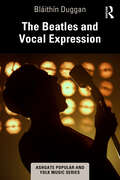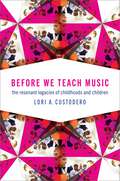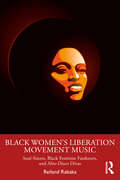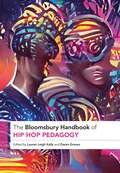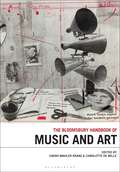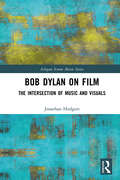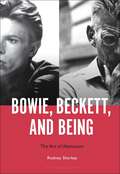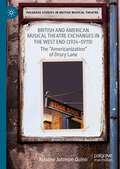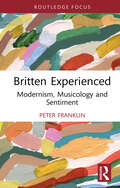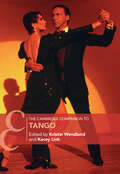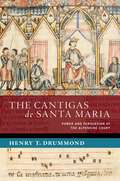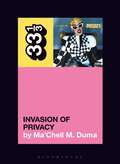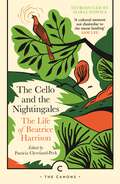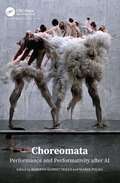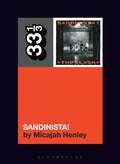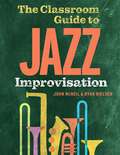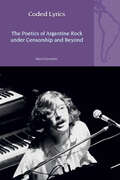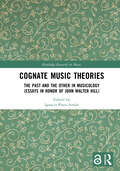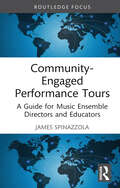- Table View
- List View
The Beatles and Vocal Expression (Ashgate Popular and Folk Music Series)
by Bláithín DugganThe Beatles and Vocal Expression examines popular song through the topic of paralanguage – a sub-category of nonverbal communication that addresses characteristics of speech that modify meaning and convey emotion. It responds to the general consensus regarding the limitations of Western art music notation to analyse popular song, assesses paralinguistic voice qualities giving rise to expressive tropes within and across songs, and lastly addresses gaps in existing Beatles scholarship. Taking The Beatles’ UK studio albums (1963–1970), paralinguistic voice qualities are examined in relation to concepts, characteristics, metaphors, and functions of paralanguage in vocal performance. Tropes, such as rising and falling intonation on words of woe, have historical connections to performative and conversational techniques. This interdisciplinary analysis is achieved through musicology, sound studies, applied linguistics, and cultural history. The new methodology locates paralinguistic voice qualities in recordings, identifies features, shows functions, and draws aural threads within and across popular songs.
Before We Teach Music: The Resonant Legacies of Childhoods and Children
by Lori A. CustoderoThe field of music education research is often concerned with studies and measurements that highlight the deficits rather than inquire about the developmental and dispositional strengths exhibited in children's musical behaviors. Before We Teach Music puts forth an alternative view, examining childhood as a site where enculturation mixes with individual experience to create foundational ways of being musical. Through interdisciplinary scholarship and multiple sources of data, author Lori A. Custodero reveals how our capacities to live musically and to cultivate a musical life are derived from the legacies of childhood. The book features excerpted musical autobiographies from over 200 music education graduate students that reveal the full spectrum of music's effect on developmental stages. For example, early childhood memories evoke strong associations with family members; dispositional practices and expressions of musical identities surface in middle childhood; and strong memories of disruption, renewal, and resistance tend to occur in later adolescence and early adulthood. These stories generate the reader's own recollections and provoke a process of self-reflection on how the past informs the present, and how our current actions help shape future experiences. Moreover, Before We Teach Music addresses what parents, teachers, performers, and composers learn from their encounters with children, raising important questions about the nature of musicality, the roles of music in identity, and the complexity of human musical trajectories.
Black Women's Liberation Movement Music: Soul Sisters, Black Feminist Funksters, and Afro-Disco Divas
by Reiland RabakaBlack Women’s Liberation Movement Music argues that the Black Women’s Liberation Movement of the mid-to-late 1960s and 1970s was a unique combination of Black political feminism, Black literary feminism, and Black musical feminism, among other forms of Black feminism. This book critically explores the ways the soundtracks of the Black Women’s Liberation Movement often overlapped with those of other 1960s and 1970s social, political, and cultural movements, such as the Black Power Movement, Women’s Liberation Movement, and Sexual Revolution. The soul, funk, and disco music of the Black Women’s Liberation Movement era is simultaneously interpreted as universalist, feminist (in a general sense), and Black female-focused. This music’s incredible ability to be interpreted in so many different ways speaks to the importance and power of Black women’s music and the fact that it has multiple meanings for a multitude of people. Within the worlds of both Black Popular Movement Studies and Black Popular Music Studies there has been a long-standing tendency to almost exclusively associate Black women’s music of the mid-to-late 1960s and 1970s with the Black male-dominated Black Power Movement or the White female-dominated Women’s Liberation Movement. However, this book reveals that much of the soul, funk, and disco performed by Black women was most often the very popular music of a very unpopular and unsung movement: The Black Women’s Liberation Movement. Black Women’s Liberation Movement Music is an invaluable resource for students, teachers, and researchers of Popular Music Studies, American Studies, African American Studies, Critical Race Studies, Gender Studies, and Sexuality Studies.
Black Women's Liberation Movement Music: Soul Sisters, Black Feminist Funksters, and Afro-Disco Divas
by Reiland RabakaBlack Women’s Liberation Movement Music argues that the Black Women’s Liberation Movement of the mid-to-late 1960s and 1970s was a unique combination of Black political feminism, Black literary feminism, and Black musical feminism, among other forms of Black feminism. This book critically explores the ways the soundtracks of the Black Women’s Liberation Movement often overlapped with those of other 1960s and 1970s social, political, and cultural movements, such as the Black Power Movement, Women’s Liberation Movement, and Sexual Revolution. The soul, funk, and disco music of the Black Women’s Liberation Movement era is simultaneously interpreted as universalist, feminist (in a general sense), and Black female-focused. This music’s incredible ability to be interpreted in so many different ways speaks to the importance and power of Black women’s music and the fact that it has multiple meanings for a multitude of people. Within the worlds of both Black Popular Movement Studies and Black Popular Music Studies there has been a long-standing tendency to almost exclusively associate Black women’s music of the mid-to-late 1960s and 1970s with the Black male-dominated Black Power Movement or the White female-dominated Women’s Liberation Movement. However, this book reveals that much of the soul, funk, and disco performed by Black women was most often the very popular music of a very unpopular and unsung movement: The Black Women’s Liberation Movement. Black Women’s Liberation Movement Music is an invaluable resource for students, teachers, and researchers of Popular Music Studies, American Studies, African American Studies, Critical Race Studies, Gender Studies, and Sexuality Studies.
The Bloomsbury Handbook of Hip Hop Pedagogy (Bloomsbury Handbooks)
by Lauren Leigh Kelly and Daren GravesThe Bloomsbury Handbook of Hip Hop Pedagogy is the first reference work to cover the theory, history, research methodologies, and practice of Hip Hop pedagogy. Including 20 chapters from activist-oriented and community engaged scholars, the handbook provides perspectives and studies from across the world, including Brazil, the Caribbean, Scandinavia, and the USA. Organized into four topical sections focusing on the history and cultural roots of Hip Hop; theories and research methods in Hip Hop pedagogy; and Hip Hop pedagogy in practice, the handbook offers theoretical, analytical, and pedagogical insights emerging across sociology, literacy, school counselling and youth organizing. The chapters reflect the impact of critical Hip Hop pedagogies and Hip Hop-based research for educators and scholars interested in radical, transformative approaches to education. Ultimately, the many voices included in the handbook show that Hip Hop pedagogy is a humanizing and emancipatory approach which is redefining the purposes and practices of education.
The Bloomsbury Handbook of Music and Art (Bloomsbury Handbooks)
by Sarah Mahler Kraaz and Charlotte de MilleThis volume brings together prominent scholars, artists, composers, and directors to present the latest interdisciplinary ideas and projects in the fields of art history, musicology and multi-media practice. Organized around ways of perceiving, experiencing and creating, the book outlines the state of the field through cutting-edge research case studies. For example, how does art-music practice / thinking communicate activist activities? How do socio-economic and environmental problems affect access to heritage? How do contemporary practitioners interpret past works and what global concerns stimulate new works? In each instance, examples of cross or inter-media works are not thought of in isolation but in a global historical context that shows our cultural existence to be complex, conflicted and entwined. For the first time cross-disciplinary collaborations in ethnomusicology-anthropology, ecomusicology-ecoart-ecomuseology and digital humanities for art history, musicology and practice are prioritized in one volume.
Bob Dylan on Film: The Intersection of Music and Visuals (Ashgate Screen Music Series)
by Jonathan HodgersIn May 1967, during a discussion about his yet-to-be-released film Eat the Document, Bob Dylan cryptically remarked, ‘The film is finished. It’s different.’ It would not be the last time he could make this claim. Beyond his musical prowess, Dylan’s career encompasses a lesser-explored facet – that of a filmmaker creating works that defy convention. This book delves into these cinematic forays, unravelling the intriguing interplay of Dylan’s presence both behind and in front of the camera.Dylan’s cinematic experiments, ranging from the ground-breaking Dont Look Back (1967) to the enigmatic Masked and Anonymous (2003), stand as unique and thought-provoking additions to his artistic legacy. Unveiling an experimental and inquisitive sensibility, these films draw inspiration not only from cinematic predecessors but also from Dylan’s songcraft. Often residing in the periphery of Dylan studies, a closer examination of his cinematic oeuvre reveals an underrated auteur who fearlessly transcends the boundaries of the page, stage, and screen.
Bob Dylan on Film: The Intersection of Music and Visuals (Ashgate Screen Music Series)
by Jonathan HodgersIn May 1967, during a discussion about his yet-to-be-released film Eat the Document, Bob Dylan cryptically remarked, ‘The film is finished. It’s different.’ It would not be the last time he could make this claim. Beyond his musical prowess, Dylan’s career encompasses a lesser-explored facet – that of a filmmaker creating works that defy convention. This book delves into these cinematic forays, unravelling the intriguing interplay of Dylan’s presence both behind and in front of the camera.Dylan’s cinematic experiments, ranging from the ground-breaking Dont Look Back (1967) to the enigmatic Masked and Anonymous (2003), stand as unique and thought-provoking additions to his artistic legacy. Unveiling an experimental and inquisitive sensibility, these films draw inspiration not only from cinematic predecessors but also from Dylan’s songcraft. Often residing in the periphery of Dylan studies, a closer examination of his cinematic oeuvre reveals an underrated auteur who fearlessly transcends the boundaries of the page, stage, and screen.
Bowie, Beckett, and Being: The Art of Alienation
by Professor Rodney SharkeyAddressing their shared passion for literature, art, and music, this book documents how Samuel Beckett and David Bowie produce extraordinarily empathetic creative outputs that reflect the experience and the effect of alienation. Through an exploration of their artistic practices, the study also illustrates how both artists articulate shared forms of human experience otherwise silenced by normative modes of representation. To liberate these experiences, Bowie and Beckett create alternative theatrical, musical, and philosophical spaces, which help frame the power relations of the psychological, verbal, and material places we inhabit. The result is that their work demonstrates how individuals are disciplined by the implicitly repressive social order of late capitalism, while, simultaneously, offering an informed political alternative. In making the injunctions of the social order apparent, Beckett and Bowie also transgress its terms, opening up new spaces beyond the conventional identities of family, nation, and gender, until both artists finally coalesce in the quantum space of the posthuman.
British and American Musical Theatre Exchanges in the West End: The “Americanization” of Drury Lane (Palgrave Studies in British Musical Theatre)
by Arianne Johnson QuinnThis monograph centres on the history of musical theatre in a space of cultural significance for British identity, namely the Theatre Royal, Drury Lane, which housed many prominent American productions from 1924-1970. It argues that during this period Drury Lane was the site of cultural exchanges between Britain and the United States that were a direct result of global engagement in two world wars and the evolution of both countries as imperial powers. The critical and public response to works of musical theatre during this period, particularly the American musical, demonstrates the shifting response by the public to global conflict, the rise of an American Empire in the eyes of the British government, and the ongoing cultural debates about the role of Americans in British public life. By considering the status of Drury Lane as a key site of cultural and political exchanges between the United States and Britain, this study allows us to gain a more complete portrait of the musical’s cultural significance in Britain.
Britten Experienced: Modernism, Musicology and Sentiment
by Peter FranklinWho writes the books we read about music that excites us, and why? Is ‘classical music’ all about class? Related questions underpin this partly polemical study, written by an academic who believes that the Humanities, to be really humane, must confront their methods and aims. Two recent studies of Benjamin Britten have specifically interested the author, who was educated in a world where the composer was a living subject of criticism and praise, his works reflecting values, worries and dramas that were not just about ‘music’. Franklin’s response is to question the recent writers, proposing that, like theirs, his own story conditioned when and how he experienced Britten. This he unfolds autobiographically in and around the discussion of specific works. Recalling his encounters with the composer as a schoolboy, as a student and opera-goer, and then as a teacher, he challenges recent assertions about Britten and modernism in the period.
Britten Experienced: Modernism, Musicology and Sentiment
by Peter FranklinWho writes the books we read about music that excites us, and why? Is ‘classical music’ all about class? Related questions underpin this partly polemical study, written by an academic who believes that the Humanities, to be really humane, must confront their methods and aims. Two recent studies of Benjamin Britten have specifically interested the author, who was educated in a world where the composer was a living subject of criticism and praise, his works reflecting values, worries and dramas that were not just about ‘music’. Franklin’s response is to question the recent writers, proposing that, like theirs, his own story conditioned when and how he experienced Britten. This he unfolds autobiographically in and around the discussion of specific works. Recalling his encounters with the composer as a schoolboy, as a student and opera-goer, and then as a teacher, he challenges recent assertions about Britten and modernism in the period.
The Cambridge Companion to Tango (Cambridge Companions to Music)
by Kristin Wendland Kacey LinkTango music rapidly became a global phenomenon as early as the beginning of the twentieth century, with about 30% of gramophone records made between 1903 and 1910 devoted to it. Its popularity declined between the 1950s and the 1980s but has since risen to new heights. This Companion offers twenty chapters from varying perspectives around music, dance, poetry, and interdisciplinary studies, including numerous visual and audio illustrations in print and on the accompanying webpages. Its multidisciplinary approach demonstrates how different disciplines intersect through performative, historical, ethnographic, sociological, political, and anthropological perspectives. These thematic continuities illuminate diverse international perspectives and highlight how the art form flourished in Argentina, Uruguay and abroad, while tracing its international and cultural impact over the last century. This book is an innovative resource for scholars and students of tango music, particularly those seeking a diverse international perspective on the subject.
The Cantigas de Santa Maria: Power and Persuasion at the Alfonsine Court (NEW CULTURAL HISTORY OF MUSIC SERIES)
by Henry T. DrummondAlfonso X (1221-84) ruled over the Crown of Castile from 1252 until his death. Known as "the Wise," he oversaw the production of a wealth of literature in his scriptorium. One of the most impressive of these literary outputs is the collection of songs known as the Cantigas de Santa Maria, which by most counts comprises 429 songs preserved in four manuscripts. The miracle songs (or cantigas de miragre) form the focus of this book. While the Cantigas have been the subject of much scholarly attention, only a handful of studies have looked at the repertory through an interdisciplinary lens. Fewer still have probed how the Cantigas use the power of song as a communicative medium, one that functions as a social tool within the erudite environment of the Alfonsine court. This book offers a new perspective to the song collection, probing how the Cantigas use their music and text, together with rhetorical devices, to communicate with their desired audience. Author Henry T. Drummond builds upon previous methodologies, adopting a novel and holistic assessment of the songs' melodies, poetic features, and narrative logic to assess a wide selection of songs. He presents a nuanced understanding of a song form that effectively conveys its narratives to its listeners via a diverse combination of tools, embracing medieval rhetoric, rhyme-based play, and song's inherent ludic potential. Such devices, Drummond argues, allow for the Cantigas to loom large as propaganda pieces, designed to dignify Alfonso X through an elaborately devised courtly ritual.
Cardi B's Invasion of Privacy (33 1/3)
by Ma’Chell M. DumaThe apex of critical praise and commercial success is a metric achieved by a select few. In 2020, Cardi B became synonymous with “record breaking” as her debut album Invasion of Privacy went five times platinum and became the longest charting record by a female rapper in history. From streaming and charting to views, likes, retweets, and shares, Cardi dominates. Cardi B's ascension to stardom is pure 21st century: from welfare kid to unapologetic stripper; reality TV persona, to social media maven, to a household name delivering one of the consummately executed albums in rap history, it's easy to imagine future critics noting popular music as before and after the rise of Cardi B.This in-depth look at Invasion of Privacy explores the sexual politics of hip hop through a track-by-track breakdown of the album. It addresses questions like: How does the wage gap impact pop music? Has Cardi destigmatized sex work for artists? What would hip hop look like as a matriarchy? Each chapter explores the musicality and social constructs that shape the album and a new movement in femme rap.
The Cello and the Nightingales: The Life of Beatrice Harrison (Canons)
by Beatrice Harrison Patricia Cleveland-PeckIn 1924, Beatrice Harrison broadcast a miracle to the world: a wild nightingale singing with her cello. Over a million people tuned in to hear the nightingale that night, and the BBC went on to broadcast their duet worldwide every spring until 1942. This transformed the public interest in nightingales – a species already in decline. If Beatrice’s duets with the nightingales touched a chord with the world, her own life proved to be as musical, free-spirited and inspiring. From her early years as a musical prodigy to recording with the most important composers of the day or playing for the wounded in the Second World War, Beatrice’s warmth and love for sharing music are as endearing now as they were to her original audiences.
Choreomata: Performance and Performativity after AI
Is artificial intelligence (AI) becoming more and more expressive, or is human thought adopting more and more structures from computation? What does it mean to perform oneself through AI, or to construct one’s subjectivity through AI? How does AI continue to complicate what it means to have a body? Has the golden age of AI, especially with regards to creative applications, already ended? Choreomata: Performance and Performativity after AI is a book about performance and performativity, but more specifically, it is a book about the performance of artificiality and the performance of intelligence. Both humans and human-designed computational forces are thoroughly engaged in an entangled, mutual performance of AI. Choreomata spins up a latticework of interdisciplinary thought, pairing theoretical inquiry from philosophy, information theory, and computer science with practical case studies from visual art, dance, music, and social theory. Through cross-disciplinary proportions and a diverse roster of contributors, this book contains insights for computer scientists, social scientists, industry professionals, artists, and beyond.
Choreomata: Performance and Performativity after AI
by Roberto Alonso TrilloIs artificial intelligence (AI) becoming more and more expressive, or is human thought adopting more and more structures from computation? What does it mean to perform oneself through AI, or to construct one’s subjectivity through AI? How does AI continue to complicate what it means to have a body? Has the golden age of AI, especially with regards to creative applications, already ended? Choreomata: Performance and Performativity after AI is a book about performance and performativity, but more specifically, it is a book about the performance of artificiality and the performance of intelligence. Both humans and human-designed computational forces are thoroughly engaged in an entangled, mutual performance of AI. Choreomata spins up a latticework of interdisciplinary thought, pairing theoretical inquiry from philosophy, information theory, and computer science with practical case studies from visual art, dance, music, and social theory. Through cross-disciplinary proportions and a diverse roster of contributors, this book contains insights for computer scientists, social scientists, industry professionals, artists, and beyond.
The Clash's Sandinista! (33 1/3)
by Micajah HenleyFollowing the success of their instantly iconic double LP, London Calling, The Clash set out to do something “triply outrageous.” Named after the Nicaraguan rebels who successfully overthrew an authoritarian dictator, Sandinista! consists of 36 songs across six sides of vinyl. Produced by the band, it showcases their politics as well as their ability to adopt a multitude of genres ranging from punk, reggae, jazz, gospel, calypso, and hip hop. Free from the influence of their Machiavellian manager, Bernie Rhodes, The Clash still battled their record label to release the triple LP on their terms: three for the price of one.Despite its polarizing reception from critics at the time of its release, Sandinista! is often considered one of the greatest albums of all time. Nevertheless, critics and fans have spent over 40 years debating whether the album would be better as a 12-track LP. This book entertains that idea and considers what is lost or gained in the process. To do so, the book delves into the politics of The Clash, the spliff bunkers constructed for the production of the album, and the sacrifices made upon its release. It examines the album's 36 tracks and considers the significance of the record's dissection on behalf of fans who curate their own versions of the album in the mixtape, CD, and playlist eras.
The Classroom Guide to Jazz Improvisation
by John McNeil Ryan NielsenYou don't have to be a jazz expert to give your students a great introduction to improvisation. The Classroom Guide to Jazz Improvisation provides what music educators have sought for decades: an easy, step-by-step guide to teaching jazz improvisation in the music classroom. Offering classroom-tested lesson plans, authors John McNeil and Ryan Nielsen draw on their combined 54 years of teaching experience and extensive work as professional jazz musicians to remove the guesswork and mystique from the teaching process. Each lesson is founded in the authors' realization that the brain responds differently to improvisation than it does rote memory. The resulting lesson plans are flexible, easy to use, and equip students with a quick understanding of the simple choices they can make to create effective jazz lines. Lessons are designed for a range of settings, from ensemble rehearsal to private instruction. Music educators may find relief in the concrete, straightforward materials on rhythm section instruments like bass, drums, piano, and guitar. Beyond the nuts and bolts of improvisation, this book contains carefully curated listening lists, honest discussions about the meaning of the music, and talking points to advocate for jazz programs to administrators and parents. With an inviting and conversational approach, The Classroom Guide to Jazz Improvisation is an essential resource for all music educators, from early career teachers to seasoned instructors.
Coded Lyrics: The Poetics of Argentine Rock under Censorship and Beyond (Liverpool Latin American Studies #31)
by Mara FavorettoCoded Lyrics is the first comprehensive academic work dedicated to unraveling the lyrical intricacies of Argentine rock in the English language. This book redefines the narrative of rock history, shedding light on the distinctive journey undertaken by South American rock music amidst a unique set of contextual challenges, far removed from its English-speaking counterparts. Within this vibrant musical landscape, Argentine rock emerges as a shining example of cultural resistance in the region. Focusing intently on Argentina's tumultuous authoritarian decades and the post-dictatorship era, this book delves deep into the heart of the Argentine rock genre's lyrical content. It vividly portrays the ongoing struggle between the state and the public, where identity, language, and perception converge around the powerful medium of rock music. Coded Lyrics is not a conventional musicological study; instead, it serves as a meticulous exploration of language and culture. With captivating prose, the book unravels the genesis of Argentine rock, placing language at its epicentre. Through a thorough examination of rock lyrics, this work unveils the artful manipulation of language as a vehicle for resistance. It illuminates the unexpected consequences of censorship in Argentina, with Argentine rock lyrics standing as a compelling testament to the transformative power of art in the face of totalitarianism.
Cognate Music Theories: The Past and the Other in Musicology (Essays in Honor of John Walter Hill) (Routledge Research in Music)
by Ignacio Prats-ArolasThis volume explores the possibilities of cognate music theory, a concept introduced by musicologist John Walter Hill to describe culturally and historically situated music theory.Cognate music theories offer a new way of thinking about music theory, music history, and the relationship between insider and outsider perspectives when researchers mediate between their own historical and cultural position, and that of the originators of the music they are studying. With contributions from noted scholars of musicology, music theory, and ethnomusicology, this volume develops a variety of approaches using the cognate music theory framework and shows how this concept enables more nuanced and critical analyses of music in historical context.Addressing topics in music from the seventeenth to nineteenth centuries, this volume will be relevant to musicologists, music theorists, and all researchers interested in reflecting critically on what it means to construct a theory of music.
Cognate Music Theories: The Past and the Other in Musicology (Essays in Honor of John Walter Hill) (Routledge Research in Music)
This volume explores the possibilities of cognate music theory, a concept introduced by musicologist John Walter Hill to describe culturally and historically situated music theory.Cognate music theories offer a new way of thinking about music theory, music history, and the relationship between insider and outsider perspectives when researchers mediate between their own historical and cultural position, and that of the originators of the music they are studying. With contributions from noted scholars of musicology, music theory, and ethnomusicology, this volume develops a variety of approaches using the cognate music theory framework and shows how this concept enables more nuanced and critical analyses of music in historical context.Addressing topics in music from the seventeenth to nineteenth centuries, this volume will be relevant to musicologists, music theorists, and all researchers interested in reflecting critically on what it means to construct a theory of music.
Community-Engaged Performance Tours: A Guide for Music Ensemble Directors and Educators
by James SpinazzolaCommunity-Engaged Performance Tours addresses the role of performance touring as a form of classroom and community engagement. Performance tours have long been a part of the collegiate and high school music ensemble experience, bringing student bands, choirs, and orchestras into connection with a wide variety of audiences, venues, and cultural contexts. This book presents a new approach to the performance tour that integrates touring with community engagement and service-learning. Emphasizing reciprocity, cross-cultural exchange, and global awareness, the author addresses how visiting ensembles can work with host communities instead of performing for them. The book includes student and community perspectives and case studies from the author’s experience leading university wind symphony tours in Haiti and the Dominican Republic, and provides a practical and hands-on model for ensemble leaders and educators.
Community-Engaged Performance Tours: A Guide for Music Ensemble Directors and Educators
by James SpinazzolaCommunity-Engaged Performance Tours addresses the role of performance touring as a form of classroom and community engagement. Performance tours have long been a part of the collegiate and high school music ensemble experience, bringing student bands, choirs, and orchestras into connection with a wide variety of audiences, venues, and cultural contexts. This book presents a new approach to the performance tour that integrates touring with community engagement and service-learning. Emphasizing reciprocity, cross-cultural exchange, and global awareness, the author addresses how visiting ensembles can work with host communities instead of performing for them. The book includes student and community perspectives and case studies from the author’s experience leading university wind symphony tours in Haiti and the Dominican Republic, and provides a practical and hands-on model for ensemble leaders and educators.
